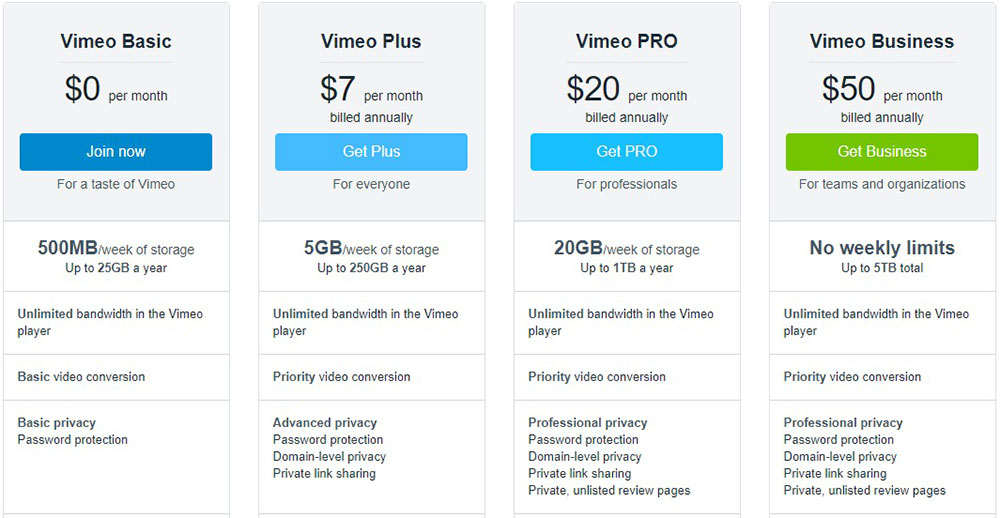

#Free vimeo plan plus
But even on their entry-level Plus plan Vimeo aims to respond to email queries within four hours during US business hours. It’s worth mentioning that you will have to pay for the privilege. Vimeo offers various levels of technical support and – this can prove extremely useful for less experienced video creators. It’s tough to compete with free, so that’s another victory for YouTube. In YouTube’s case, yep, you’ve guessed it, you get unlimited storage completely free.

Their paid plans range from 5GB of uploads a week and 250GB of storage a year through to no weekly limit and a total storage of 7TB.
#Free vimeo plan free
The basic free plan offers 500MB a week, which is unlikely to be enough to do much at all. Vimeo’s tiered pricing plans offer a sliding scale of storage options with a price to match. That’s another win for Vimeo! The Vimeo vs YouTube contest is heating up! Most videos on YouTube will stream in 128 kbps as standard or 256 kbps with a premium subscription.
#Free vimeo plan 320 kbps
Vimeo users have the advantage here because, unlike YouTube, Vimeo videos can be reinforced by playback at 320 kbps – the highest quality MP3 bitrate possible. Generally speaking, the higher the bitrate, the better the audio. Audio quality Image: Photo by Daniel Schludi on UnsplashĪlthough YouTube and Vimeo offer a similar level of video quality in theory, audio quality is one area where they definitely differ.īitrates represent the amount of data transferred into audio. Both will also play a video in the most relevant resolution based on the viewer’s internet bandwidth.Īlthough there are plenty of anecdotal comparisons that claim YouTube videos appear less crisp in 4K than Vimeo’s, there’s little concrete evidence to back up these claims.

Vimeo and YouTube both impart a certain amount of compression to make videos smaller for storage purposes. Although take up is relatively slow at this point. In fact, just as Vimeo supports the upload and playback of 8K Ultra High Definition (UHD) videos – the highest video resolution currently available – so does YouTube.

YouTube is often, and perhaps unfairly, maligned for its video and audio quality. Perhaps unsurprisingly, Google is known to favour videos that appear on YouTube over others. Which in and of itself is the second largest search engine and website after its parent site. Well, the biggest search engine in the world, Google, just so happens to own YouTube. When it comes to search engine optimisation, the odds are heavily stacked in YouTube’s favour. This time the Vimeo vs YouTube contest swings back in favour of Vimeo. Vimeo’s community is also reputedly more supportive than what you routinely see in YouTube comment threads. Whereas Vimeo’s smaller, more specialised audience base can provide better opportunities to reach more people and – crucially – the right type of people. With 2,500 new videos uploaded every minute, you’ll be competing in a heavily saturated market. YouTube’s huge global following only tells part of the story. That’s another win for YouTube in the Vimeo vs YouTube stakes. Whereas YouTube offers unlimited storage for free. It’s really quite limited in that it only gives you 500MB a week of upload space and up to 5GB of storage in total. Their free plan, Vimeo Basic, is aptly named. Each offers varying amounts of weekly storage limits with the Premium plan also providing unlimited live streaming. Vimeo offers four different packages for businesses: Plus, Pro, Business and Premium. If your overall aim is to reach the biggest audience possible, YouTube wins hands down. That’s nearly half of all the 4.6 billion active internet users worldwide – such a massive audience! While Vimeo’s 230+ million monthly users is nothing to be sniffed at, this figure pales in comparison to the more than 2 billion monthly logged in users that YouTube attracts. In terms of sheer numbers, YouTube absolutely dominates Vimeo – it is the world’s second most visited website after all.


 0 kommentar(er)
0 kommentar(er)
